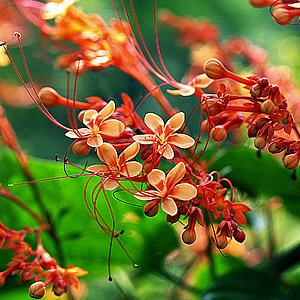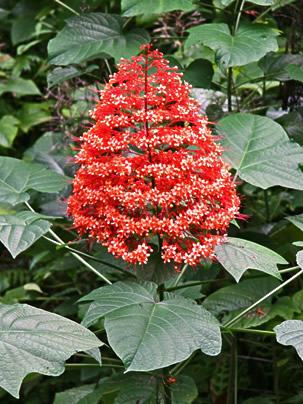The pagoda flower (Clerodendrum paniculatum) is a semi-woody shrub with showy flowering and is native to tropical regions of Asia and Oceania. Diverse stems, sparse, upright, and sparsely branched, emerge directly from its roots, giving the plant an open and informal appearance. The leaves are large, opposite, evergreen, heart-shaped, with lobed lower leaves and entire upper leaves.
In warm climates, it can bloom throughout the year, with greater intensity in the summer. In subtropical to temperate climates, flowering begins in the summer and lasts until the end of autumn. Although often described as panicles, its inflorescences are actually mixed thyrses (a raceme of cymes). They are stunning, pyramid-shaped, and emerge above the foliage, reaching up to 45 cm in height.
The flowers are tubular, pentamerous, reddish-orange, with long stamens. There is a variety of lemon-yellow flowers, the C. paniculatum ‘Alba.’ They are highly attractive to butterflies and hummingbirds, their pollinators. This species generally does not produce seeds outside its habitat. The fruits are globose drupes.

The pagoda flower has a strong tropical appeal due to its large leaves and informal aspect. Despite this, it also blends well with cottage and oriental-style gardens. It is especially suitable for humid areas with drainage issues, as it prefers constant soil moisture.
Therefore, it can be used individually as a focal point, combined with other species, or in groups, forming masses and rows along walls, in open areas, or under tree canopies. Over time, the lower leaves tend to yellow, giving an untidy appearance, so it’s interesting to pair it with another plant that serves as a border.
It should be grown in full sun or partial shade, in fertile soil enriched with organic matter, and kept moist. It is not drought-tolerant. In temperate climates, the pagoda flower suffers in winter and should preferably be protected. Harsh and successive winters tend to weaken and decline the plant.
Despite being quite robust, it is not a very long-lived plant, and replacement may be necessary after a few years. Fertilize sparingly and apply fertilizer bi-weekly during the growth and flowering period. It propagates through semi-woody or root cuttings, placed to root in spring, and more easily through the separation of shoots that emerge around the mother plant.


